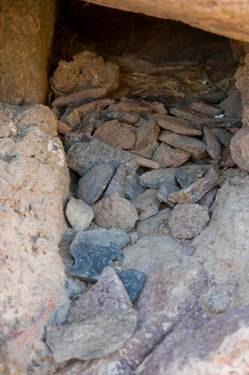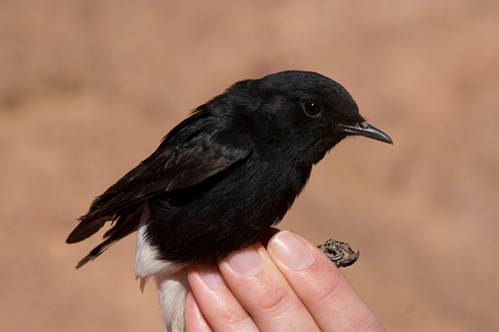Behaviour and Ecology
@ School of Life Sciences,
University of Nottingham
| Home | People | Research | Teaching | Publications | Opportunities | Links |
Bird behavoural ecology
Ecology of the white-crowned black wheatear (Oenanthe leucopyga) - Kate Durrant
Around
the town of St Katherine, nestled in a bowl created
by the beautiful Sinai mountains, many species of birds can be found
inhabiting
the gardens maintained by the Bedu. Many pass through on migration, but
a few
species remain all year. The most recognisable is the WCB wheatear, or
Baga’a
as the Bedu call them. They live in apparently permanent territories.
We have
established a colour-banded population of Baga’a, and have been
studying their
behaviour, ecology and life history. We invite MRes students, or
self-funded
PhD candidates, to apply to continue field work in this remote but
stunning
region, and build up our knowledge of this fascinating little bird.
 Stone rampart building
Stone rampart building
The
oddest thing about the Baga’a is their nesting habits.
They build a standard cup-shaped nest, placed in a rock crevice. So
far, so
good. Before this, the female collects hundreds of tiny flat stones and
lays a
pavement, or rampart, from the front of the rock crevice right
underneath the
nest cup. Our research has shown that there can be thousands of stones,
all
similar in shape, perhaps gathered over many seasons. Why do this?
There are
several competing theories, which we are currently trying to unravel.
It may be
for predator protection, or for thermoregulation: there are many
possibilities.
Building the rampart also imposes a cost on the female: could it be a
test of
her quality?
Display behaviour
Male
Baga’a have a varied repertoire of calls and song. They
can mimic other bird species in the area, such as the Scrub warbler (Scotocerca inquieta) and Tristram’s
grackle (Onychognathus tristamii).
They have unusual, potentially aggressive, ‘white rump’ displays, and
an
incredible ‘dance flight’ that they perform for their female prior to
mating.
We do not yet have a good grasp on the timing and function of any of
these
behaviours. The Baga’a also sports, as its English name suggests, a
white
crown. This only develops in their third year, and potentially gives a
reliable
way to age birds for the first few years of their lives. Birds can
breed when
still in black-crowned plumage, and females especially seem to be
black-crowned
in a greater proportion of their lives. Does crown colour have a role
in
signalling age and quality? Are old birds indeed ‘good’ birds?
 Desert survivor
Desert survivor
Baga’a
are common, ideal for a field-based project. They
respond very quickly to any improvement in environmental conditions and
produce
several broods each spring. They are intimately connected with the
lives of the
Bedu (see below), but are also found breeding in more remote wadis (dry
river
beds). The secret appears to lie in being a food generalist, but their
diet is
poorly known. Little is known about feeding of chicks and fledglings,
which remain
dependent for a period of time. Over the longer term, we know little
about
their survival strategies and lifetime reproductive success, and
nothing about
territory turnover.
Interactions with
humans
The
Baga’a are a great favourite of the local Bedu, our
hosts and guides in Sinai. The birds have a ‘confiding’ nature similar
to
European robins (Erithacus rubecula).
A Baga’a is always welcome in a bedouin garden - those with white
crowns are
called ‘birds of happiness’. No matter how tough the times, the Bedu
try to
spare some water and food for their avian friends: they have many folk
tales
about the Baga’a, including stories of how they have saved people’s
lives by
warning them of approaching snakes. What is it that enables a species
to become
so well adapted to living with humans? Is there a genetic correlate
shared with
other species, such as robins, that allows them to prosper from the
generosity
of humans? Is this a learned behaviour, and can any species accomplish
this
trick?


